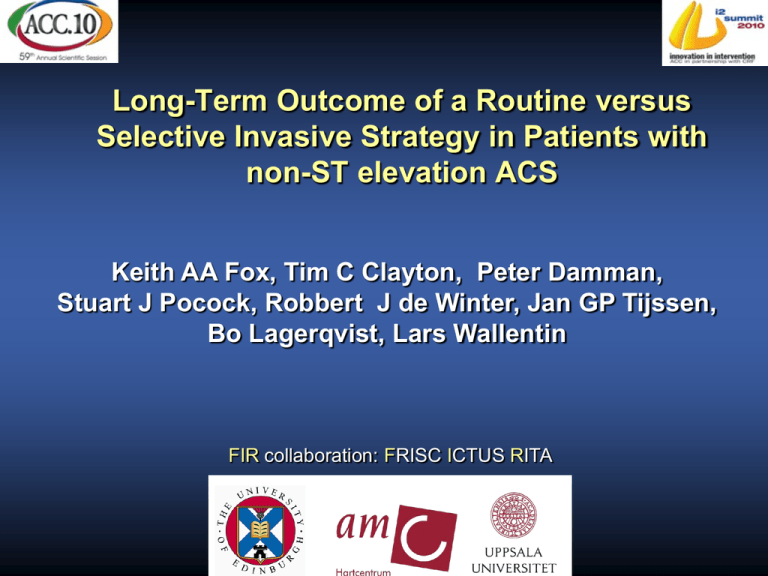
Long-Term Outcome of a Routine versus
Selective Invasive Strategy in Patients with
non-ST elevation ACS
Keith AA Fox, Tim C Clayton, Peter Damman,
Stuart J Pocock, Robbert J de Winter, Jan GP Tijssen,
Bo Lagerqvist, Lars Wallentin
FIR collaboration: FRISC ICTUS RITA
ACC/AHA Recommendations for Invasive and
Medical Strategies in Patients with NSTE-ACS
• Class I
• An early invasive strategy in patients with high-risk
indicators
• In the absence of any of the above high-risk
indicators, either an early conservative or an early
invasive strategy
• Class IIb Level of Evidence: B
• In initially stabilized patients a selectively invasive
strategy may be considered as a treatment
strategy
Available at www.acc.org/clinical/guidelines/unstable/unstable.pdf.
European Heart Journal (2007) 28, 1598–1660
Routine versus selective intervention in ACS
Early invasive strategy: OR 0.84 (95% CI 0.73-0.97)
ESC Guidelines for the Management of NSTE-ACS
n = 1810
RITA-3: 5-year mortality
OR 0.76 (95%CI: 0.58-1.00, p=0.054)
Selective invasive
Routine
invasive
n = 2457
FRISC II: 5-year
mortality
RR 0.95 (95%CI: 0.75-1.21, p=0.693)
Selective invasive
ICTUS: 5-year mortality
HR 1.13 (95%CI: 0.80-1.60, p=0.52)
n = 1190
Routine invasive
Routine invasive
Selective
invasive
Short-term outcomes (up to one year)
showed a net benefit (death/MI) , but long
term outcomes were inconsistent in
individual studies
Aims of the Meta-analysis:
• To determine whether;
A routine invasive strategy reduces cardiovascular death
or MI using a meta-analysis of individual patient data from
all randomised studies with 5 year outcome
• The results are influenced by baseline risk of the patients
FIR patient-pooled database
• Core variables:
•
•
•
•
•
•
Demographics
Clinical history
Risk factors for CAD
Baseline ECG characteristics
Baseline laboratory results
5-year clinical outcomes
• 5467 patients with nSTE-ACS included
Procedures
• Routine invasive strategy
• “Early” angiography with subsequent PCI or
CABG
• Selective invasive strategy
• Angiography only if refractory angina or rest
ischemia occurs despite optimal medical
therapy
Baseline characteristics
Routine invasive
(n=2721)
Selective invasive
(n=2746)
Age – median (IQR)
64 (56-72)
63 (56-71)
Body-mass index – mean (SD)
27.1 (4.0)
27.3 (4.2)
68.5
67.4
Myocardial infarction
25.7
22.8
PCI
6.1
5.4
CABG
2.5
1.7
Current cigarette smoking
32.3
34.4
Hypertension
33.3
34.0
Hypercholesterolemia
23.6
22.5
Diabetes
13.6
12.3
ST-segment depression ≥0.1mV
42.8
43.3
Left bundle branch block
2.6
2.6
P-value
Demographics
Male sex - %
Clinical history - %
Risk factors - %
ECG abnormalities - %
0.015
0.052
Timing of first coronary revascularization
Cumulative percentage
100
Selective invasive
Routine invasive
80 64.1%
71.8%
73.3%
60
17.6%
41.6%
47.8%
40
20
Revasc at 1yr %
Routine invasive
ICTUS 0
FRISC II
RITA-3
0
1
Selective invasive
79
2
3
78
Follow-up time (years)
57
54
4
44
28
5
Primary outcomes at 5 years
Combined dataset
Hazard ratio
p-value
Selective
invasive
n = 2746
Routine
invasive
n = 2721
(95% CI)
MI
338
12.9%
260
10.0%
0.77
(0.65 - 0.90)
0.001
CV death
218
8.1%
181
6.8%
0.83
(0.68 - 1.01)
0.068
CV
death/MI
475
17.9%
389
14.7%
0.81
(0.71 -0.93)
0.002
Outcomes at 5 years
Combined dataset
Hazard ratio
pvalue
Selective
invasive
Routine
invasive
(95% CI)
All-cause
death
321
11.7%
288
10.6%
0.90
(0.77 -1.05)
0.19
All-cause
death/MI
560
20.9%
480
18.1%
0.85
(0.75 - 0.96)
0.008
Meta-analysis for CV death or MI
Study
Hazard ratio (95% CI)
FRISC-II (N=2457)
0.79 (0.66, 0.95)
RITA-3
(N=1810)
0.75 (0.58, 0.96)
ICTUS
(N=1200)
0.99 (0.72, 1.35)
Overall
0.81 (0.71, 0.93)
0.5
0.75
1
1.33
2
Favors routine invasive
Favors selective invasive
Hazard ratio
Cumulative risk of CV death or MI
25
Selective invasive
Cumulative percentage
17.9%
Routine invasive
20
15
14.7%
10
HR 0.81 95% CI 0.71-0.93
p = 0.002
5
0
0
1
2
3
4
5
2077
2166
1880
1952
Follow-up time (years)
SI
RI
2746
2721
2452
2485
2351
2410
2178
2235
Are the results influenced by the baseline risk of
the patients?
• Univariable and multivariable predictors
of outcome derived (Cox regression).
p<0.01 for inclusion in multivariable
model (Wald test)
• Simplified integer score derived:
• Age, diabetes, prior MI, ST depression,
hypertension, BMI
Cumulative risk of CV death or MI by risk group
Cumulative percentage
50
Selective invasive
Routine invasive
40
30
20
Intermediate
10
Low
0
0
1
2
3
4
5
2077
2166
1880
1952
Follow-up time (years)
SI 2746
RI 2721
2452
2485
2351
2410
2178
2235
Cumulative risk of CV death or MI by risk group
50
Selective invasive
Routine invasive
Cumulative percentage
40
High
30
20
Intermediate
10
Low
0
0
1
2
3
4
5
2077
2166
1880
1952
Follow-up time (years)
SI 2746
RI 2721
2452
2485
2351
2410
2178
2235
Cumulative risk of MI by risk group
50
Selective invasive
Routine invasive
Cumulative percentage
40
30
High
20
Intermediate
10
Low
0
0
1
2
3
4
5
2077
2166
1880
1952
Follow-up time (years)
SI 2746
RI 2721
2452
2485
2351
2410
2178
2235
Risk of CV death or MI within 5 years
Probability of CV death or MI at 5 years
70
60
Predicted risk on selective invasive
Predicted risk on routine invasive
50
40
30
20
ROC statistic 0.69
10
0
0 1 2 3 4 5 6 7 8 9 10 11 12 13 14 15
Integer score
Integer
age245
0-5:
0-4:15
No. of patients 431 525
615 score
761 594components
596 490 415 :331
174Diabetes
139 82 31
(total=5467)
Hypertension 0-1: ST depression 0-2: BMI 0-2
23
Treatment Effect by Integer Risk Category:
Cardiovascular Death or MI
Risk
group
Risk
score
Low
53%
0-4
Mid
34%
5-8
High
13%
≥9
Total
Treatment group
Hazard ratio
Absolute risk
difference
Selective
invasive
Routine
invasive
(95% CI)
(95% CI)
10.2%
8.2%
0.80
-2.0%
(0.63 - 1.02)
(-4.1% - 0.1%)
0.81
-3.8%
(0.66 - 1.01)
(-7.4% -0.1%)
0.68
-11.1%
21.1%
44.1%
17.3%
33.0%
(0.53 - 0.86) (-18.4% -3.8%)
475 / 2746
389 / 2721
17.9%
14.7%
Summary
• The routine invasive strategy reduces
cardiovascular death or MI at long-term follow-up
• 3.2% absolute risk reduction in CV death/MI
• 19% relative risk reduction
• Risk stratification identifies the patient group with
the greatest absolute benefits
• 11.1% absolute risk reduction in highest risk patients
• The absolute risk reductions in CV death/MI in
low (2.0%) and Intermediate groups (3.8%)
exceed those seen in many trials of
pharmacological agents










